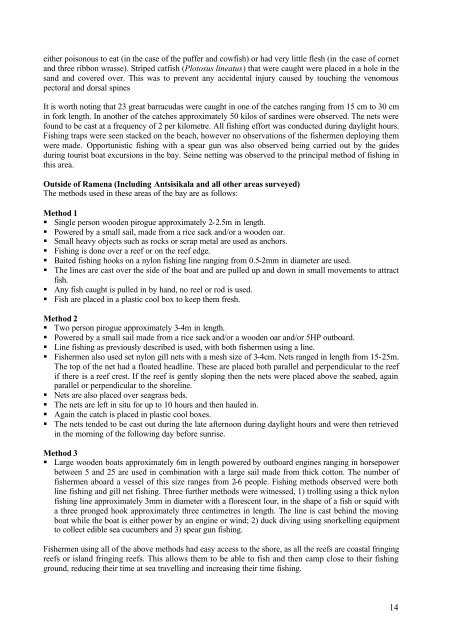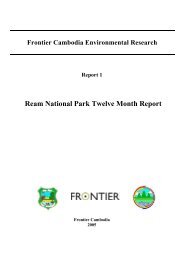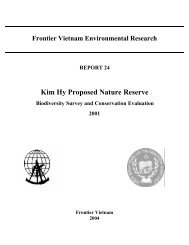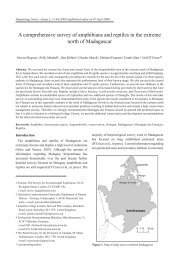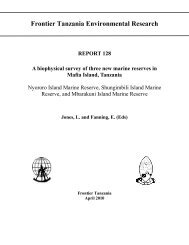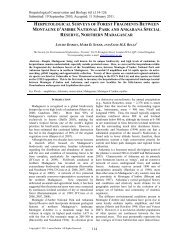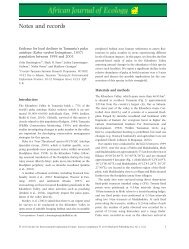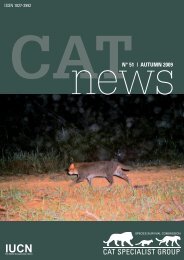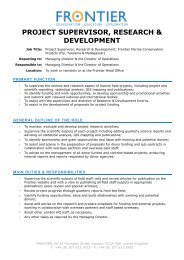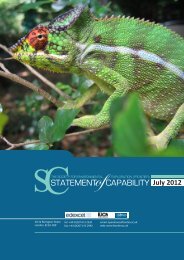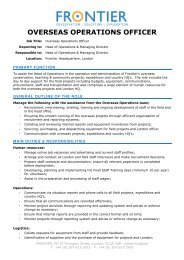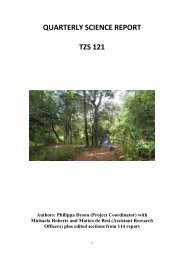An assessment of local fisheries in Diego-Suarez Bay, Madagascar
An assessment of local fisheries in Diego-Suarez Bay, Madagascar
An assessment of local fisheries in Diego-Suarez Bay, Madagascar
Create successful ePaper yourself
Turn your PDF publications into a flip-book with our unique Google optimized e-Paper software.
either poisonous to eat (<strong>in</strong> the case <strong>of</strong> the puffer and cowfish) or had very little flesh (<strong>in</strong> the case <strong>of</strong> cornet<br />
and three ribbon wrasse). Striped catfish (Plotosus l<strong>in</strong>eatus) that were caught were placed <strong>in</strong> a hole <strong>in</strong> the<br />
sand and covered over. This was to prevent any accidental <strong>in</strong>jury caused by touch<strong>in</strong>g the venomous<br />
pectoral and dorsal sp<strong>in</strong>es<br />
It is worth not<strong>in</strong>g that 23 great barracudas were caught <strong>in</strong> one <strong>of</strong> the catches rang<strong>in</strong>g from 15 cm to 30 cm<br />
<strong>in</strong> fork length. In another <strong>of</strong> the catches approximately 50 kilos <strong>of</strong> sard<strong>in</strong>es were observed. The nets were<br />
found to be cast at a frequency <strong>of</strong> 2 per kilometre. All fish<strong>in</strong>g effort was conducted dur<strong>in</strong>g daylight hours.<br />
Fish<strong>in</strong>g traps were seen stacked on the beach, however no observations <strong>of</strong> the fishermen deploy<strong>in</strong>g them<br />
were made. Opportunistic fish<strong>in</strong>g with a spear gun was also observed be<strong>in</strong>g carried out by the guides<br />
dur<strong>in</strong>g tourist boat excursions <strong>in</strong> the bay. Se<strong>in</strong>e nett<strong>in</strong>g was observed to the pr<strong>in</strong>cipal method <strong>of</strong> fish<strong>in</strong>g <strong>in</strong><br />
this area.<br />
Outside <strong>of</strong> Ramena (Includ<strong>in</strong>g <strong>An</strong>tsisikala and all other areas surveyed)<br />
The methods used <strong>in</strong> these areas <strong>of</strong> the bay are as follows:<br />
Method 1<br />
S<strong>in</strong>gle person wooden pirogue approximately 2-2.5m <strong>in</strong> length.<br />
Powered by a small sail, made from a rice sack and/or a wooden oar.<br />
Small heavy objects such as rocks or scrap metal are used as anchors.<br />
Fish<strong>in</strong>g is done over a reef or on the reef edge.<br />
Baited fish<strong>in</strong>g hooks on a nylon fish<strong>in</strong>g l<strong>in</strong>e rang<strong>in</strong>g from 0.5-2mm <strong>in</strong> diameter are used.<br />
The l<strong>in</strong>es are cast over the side <strong>of</strong> the boat and are pulled up and down <strong>in</strong> small movements to attract<br />
fish.<br />
<strong>An</strong>y fish caught is pulled <strong>in</strong> by hand, no reel or rod is used.<br />
Fish are placed <strong>in</strong> a plastic cool box to keep them fresh.<br />
Method 2<br />
Two person pirogue approximately 3-4m <strong>in</strong> length.<br />
Powered by a small sail made from a rice sack and/or a wooden oar and/or 5HP outboard.<br />
L<strong>in</strong>e fish<strong>in</strong>g as previously described is used, with both fishermen us<strong>in</strong>g a l<strong>in</strong>e.<br />
Fishermen also used set nylon gill nets with a mesh size <strong>of</strong> 3-4cm. Nets ranged <strong>in</strong> length from 15-25m.<br />
The top <strong>of</strong> the net had a floated headl<strong>in</strong>e. These are placed both parallel and perpendicular to the reef<br />
if there is a reef crest. If the reef is gently slop<strong>in</strong>g then the nets were placed above the seabed, aga<strong>in</strong><br />
parallel or perpendicular to the shorel<strong>in</strong>e.<br />
Nets are also placed over seagrass beds.<br />
The nets are left <strong>in</strong> situ for up to 10 hours and then hauled <strong>in</strong>.<br />
Aga<strong>in</strong> the catch is placed <strong>in</strong> plastic cool boxes.<br />
The nets tended to be cast out dur<strong>in</strong>g the late afternoon dur<strong>in</strong>g daylight hours and were then retrieved<br />
<strong>in</strong> the morn<strong>in</strong>g <strong>of</strong> the follow<strong>in</strong>g day before sunrise.<br />
Method 3<br />
Large wooden boats approximately 6m <strong>in</strong> length powered by outboard eng<strong>in</strong>es rang<strong>in</strong>g <strong>in</strong> horsepower<br />
between 5 and 25 are used <strong>in</strong> comb<strong>in</strong>ation with a large sail made from thick cotton. The number <strong>of</strong><br />
fishermen aboard a vessel <strong>of</strong> this size ranges from 2-6 people. Fish<strong>in</strong>g methods observed were both<br />
l<strong>in</strong>e fish<strong>in</strong>g and gill net fish<strong>in</strong>g. Three further methods were witnessed, 1) troll<strong>in</strong>g us<strong>in</strong>g a thick nylon<br />
fish<strong>in</strong>g l<strong>in</strong>e approximately 3mm <strong>in</strong> diameter with a florescent lour, <strong>in</strong> the shape <strong>of</strong> a fish or squid with<br />
a three pronged hook approximately three centimetres <strong>in</strong> length. The l<strong>in</strong>e is cast beh<strong>in</strong>d the mov<strong>in</strong>g<br />
boat while the boat is either power by an eng<strong>in</strong>e or w<strong>in</strong>d; 2) duck div<strong>in</strong>g us<strong>in</strong>g snorkell<strong>in</strong>g equipment<br />
to collect edible sea cucumbers and 3) spear gun fish<strong>in</strong>g.<br />
Fishermen us<strong>in</strong>g all <strong>of</strong> the above methods had easy access to the shore, as all the reefs are coastal fr<strong>in</strong>g<strong>in</strong>g<br />
reefs or island fr<strong>in</strong>g<strong>in</strong>g reefs. This allows them to be able to fish and then camp close to their fish<strong>in</strong>g<br />
ground, reduc<strong>in</strong>g their time at sea travell<strong>in</strong>g and <strong>in</strong>creas<strong>in</strong>g their time fish<strong>in</strong>g.<br />
14


